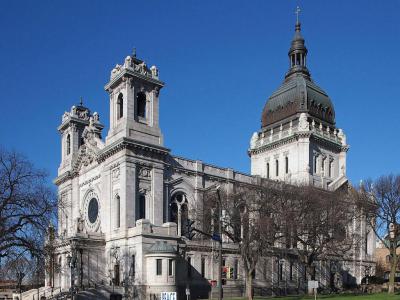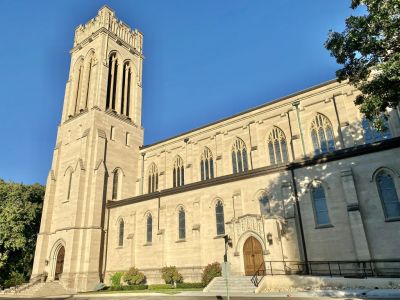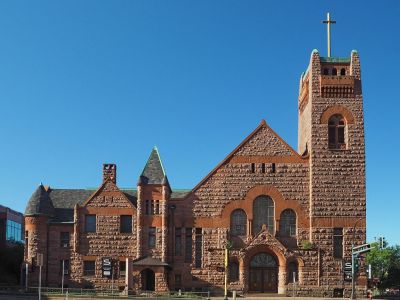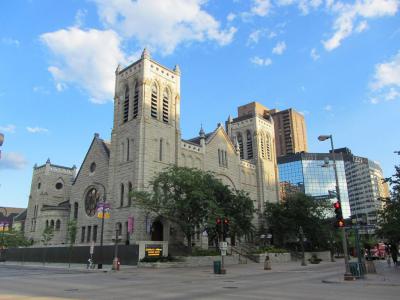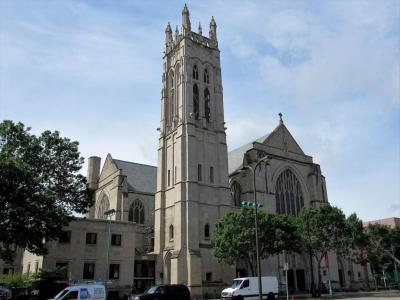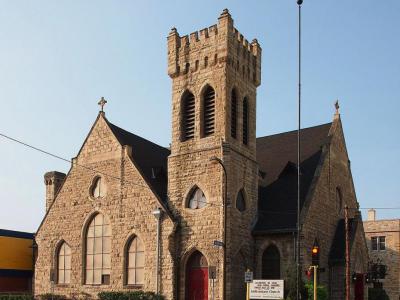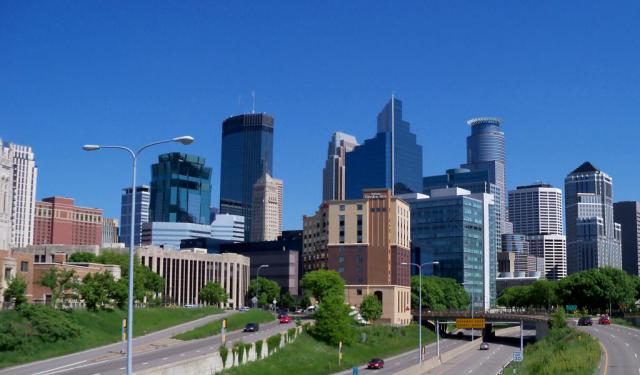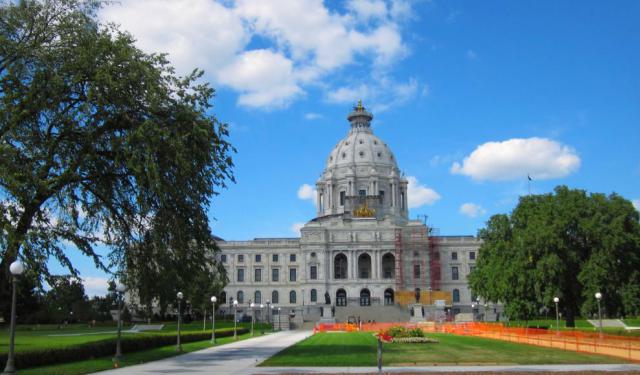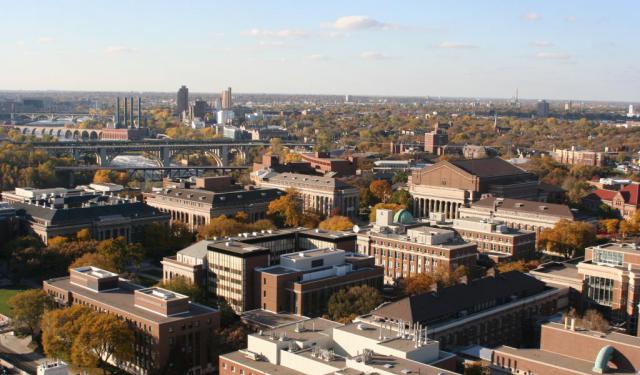
Historical Churches (Self Guided), Minneapolis
The "City of Lakes”, Minneapolis, doesn't pride itself solely on the lakes. In fact, you will be amazed by how many churches, cathedrals, and other places of worship are found throughout the city. These sacred structures have played a significant role in the development of Minneapolis and continue to serve as pillars of faith and community. Let's take a look at some of the most remarkable of them.
The architectural marvel of the Basilica of Saint Mary stands as a symbol of Catholic faith in the city. Its stunning Classical Revival design and intricate stained glass windows make it a must-visit location for those seeking spiritual solace.
Saint Mark's Episcopal Cathedral, an elegant Gothic Revival cathedral, is another notable landmark. Its towering belfry and intricate stonework create a sense of awe and reverence. The cathedral's history is intertwined with the growth of the Episcopal Church in Minneapolis.
Wesley United Methodist Church, a historic congregation, holds a special place in the city's history. It has been a center of social and religious activism, reflecting the resilience and faith of its community.
Westminster Presbyterian Church is a striking example of Romanesque-Gothic architecture. Its intricate details and impressive sanctuary have made it a beloved place for worship and community gatherings.
Central Lutheran Church, with its modernist design, stands out as a testament to the city's changing architectural landscape. It embraces a contemporary approach to faith and community engagement.
Gethsemane Episcopal Church, a charming stone church nestled in a quiet neighborhood, offers a sense of peace and serenity. It has been a source of spiritual comfort for its congregation for generations.
These historical churches not only showcase remarkable architecture but also serve as reminders of Minneapolis's diverse religious traditions and the importance of faith in the lives of its residents. So, why not take a self-guided journey and experience the sense of community they provide? Your visit may leave you inspired and spiritually enriched, offering a deeper understanding of Minneapolis's cultural tapestry.
The architectural marvel of the Basilica of Saint Mary stands as a symbol of Catholic faith in the city. Its stunning Classical Revival design and intricate stained glass windows make it a must-visit location for those seeking spiritual solace.
Saint Mark's Episcopal Cathedral, an elegant Gothic Revival cathedral, is another notable landmark. Its towering belfry and intricate stonework create a sense of awe and reverence. The cathedral's history is intertwined with the growth of the Episcopal Church in Minneapolis.
Wesley United Methodist Church, a historic congregation, holds a special place in the city's history. It has been a center of social and religious activism, reflecting the resilience and faith of its community.
Westminster Presbyterian Church is a striking example of Romanesque-Gothic architecture. Its intricate details and impressive sanctuary have made it a beloved place for worship and community gatherings.
Central Lutheran Church, with its modernist design, stands out as a testament to the city's changing architectural landscape. It embraces a contemporary approach to faith and community engagement.
Gethsemane Episcopal Church, a charming stone church nestled in a quiet neighborhood, offers a sense of peace and serenity. It has been a source of spiritual comfort for its congregation for generations.
These historical churches not only showcase remarkable architecture but also serve as reminders of Minneapolis's diverse religious traditions and the importance of faith in the lives of its residents. So, why not take a self-guided journey and experience the sense of community they provide? Your visit may leave you inspired and spiritually enriched, offering a deeper understanding of Minneapolis's cultural tapestry.
How it works: Download the app "GPSmyCity: Walks in 1K+ Cities" from Apple App Store or Google Play Store to your mobile phone or tablet. The app turns your mobile device into a personal tour guide and its built-in GPS navigation functions guide you from one tour stop to next. The app works offline, so no data plan is needed when traveling abroad.
Historical Churches Map
Guide Name: Historical Churches
Guide Location: USA » Minneapolis (See other walking tours in Minneapolis)
Guide Type: Self-guided Walking Tour (Sightseeing)
# of Attractions: 6
Tour Duration: 1 Hour(s)
Travel Distance: 2.8 Km or 1.7 Miles
Author: ChristineS
Sight(s) Featured in This Guide:
Guide Location: USA » Minneapolis (See other walking tours in Minneapolis)
Guide Type: Self-guided Walking Tour (Sightseeing)
# of Attractions: 6
Tour Duration: 1 Hour(s)
Travel Distance: 2.8 Km or 1.7 Miles
Author: ChristineS
Sight(s) Featured in This Guide:
- Basilica of St Mary
- Saint Mark's Episcopal Cathedral
- Wesley United Methodist Church
- Westminster Presbyterian Church
- Central Lutheran Church
- Gethsemane Episcopal Church
1) Basilica of St Mary (must see)
The Basilica of Saint Mary is a Roman Catholic minor basilica located on its own city block along Hennepin Avenue between 16th & 17th Streets in downtown Minneapolis. It was the first basilica established in the United States. The Basilica of Saint Mary is the Co-cathedral of the Roman Catholic Archdiocese of Saint Paul and Minneapolis and is one of the finest examples of Beaux-Arts architecture in the country.
The Basilica of Saint Mary replaced a previous church, the Church of the Immaculate Conception. The building was added to the National Register of Historic Places in 1975. Its significance is due to three reasons: its excellent architecture and engineering design, as an expression of Baroque influence in church architecture; an example of the history of religious movements in Minnesota; and its place as the first basilica in the United States.
The foundation of the church is of Rockville granite. The walls are built of white Vermont granite, with a height of 70 feet from the floor to the eave-line. The main entrance is a colonnaded portico with two 116-foot spires on each side. The nave is lighted by five large arched stained glass windows. The nave has a barrel vault of 82 feet, exceeding that of the St. Peter's Basilica by two feet. The sanctuary, at the north end of the nave, is topped with a grand dome measuring 40 feet square at the base and rising 138 feet above the floor.
The Basilica of Saint Mary replaced a previous church, the Church of the Immaculate Conception. The building was added to the National Register of Historic Places in 1975. Its significance is due to three reasons: its excellent architecture and engineering design, as an expression of Baroque influence in church architecture; an example of the history of religious movements in Minnesota; and its place as the first basilica in the United States.
The foundation of the church is of Rockville granite. The walls are built of white Vermont granite, with a height of 70 feet from the floor to the eave-line. The main entrance is a colonnaded portico with two 116-foot spires on each side. The nave is lighted by five large arched stained glass windows. The nave has a barrel vault of 82 feet, exceeding that of the St. Peter's Basilica by two feet. The sanctuary, at the north end of the nave, is topped with a grand dome measuring 40 feet square at the base and rising 138 feet above the floor.
Sight description based on Wikipedia.
2) Saint Mark's Episcopal Cathedral
Saint Mark's Episcopal Cathedral in Minneapolis, is one of two cathedrals in the Episcopal Diocese of Minnesota. It was built as a parish church overlooking Loring Park in 1910. In 1941, it was designated a cathedral when the bishop's office moved to Minneapolis from the Cathedral of Our Merciful Saviour in Faribault.
The cathedral hosted the first World Congress of the Anglican Communion to be held outside of the United Kingdom in 1954, and hosted the 1976 General Convention in Minneapolis which officially accepted the ordination of women as priests and adopted the current Book of Common Prayer used in the United States. In 2003, St. Mark's hosted the General Convention at which the election of Rt. Rev. V. Gene Robinson as Bishop of the Diocese of New Hampshire was confirmed, making him the Episcopal Church's first openly gay, noncelibate bishop.
In 2007, following the collapse of the Interstate 35W bridge in Minneapolis, St. Mark's hosted an interfaith service of healing. On June 1, 2008, St. Mark's celebrated their 150th anniversary as a parish church with a celebratory mass. There is a Biblical garden on the cathedral grounds. Composer Stanley R. Avery was choirmaster and organist at St. Mark's Church from 1910 to 1950.
The cathedral hosted the first World Congress of the Anglican Communion to be held outside of the United Kingdom in 1954, and hosted the 1976 General Convention in Minneapolis which officially accepted the ordination of women as priests and adopted the current Book of Common Prayer used in the United States. In 2003, St. Mark's hosted the General Convention at which the election of Rt. Rev. V. Gene Robinson as Bishop of the Diocese of New Hampshire was confirmed, making him the Episcopal Church's first openly gay, noncelibate bishop.
In 2007, following the collapse of the Interstate 35W bridge in Minneapolis, St. Mark's hosted an interfaith service of healing. On June 1, 2008, St. Mark's celebrated their 150th anniversary as a parish church with a celebratory mass. There is a Biblical garden on the cathedral grounds. Composer Stanley R. Avery was choirmaster and organist at St. Mark's Church from 1910 to 1950.
Sight description based on Wikipedia.
3) Wesley United Methodist Church
The Wesley United Methodist Church (formerly the Wesley Methodist Episcopal Church) building was constructed of granite, stone, brick, and sandstone in Richardsonian Romanesque style, featuring round-arched windows and multiple towers. When built, the building was in the residential neighborhood of Loring Park at 101 Grant Street East; it was built during Minneapolis' building boom in the last decade of the 19th century. Architect Warren H. Hayes (1847-1899) was Minneapolis' leading designer of churches in the 19th century, having designed the Calvary Baptist Church, Fowler Methodist Episcopal Church, and the First Congregational Church, as well as the Central Presbyterian Church in Saint Paul. Today, the location is overwhelmed by the neighboring Minneapolis Convention Center.
The church was renamed Wesley United Methodist Church when the Methodist Episcopal Church and Evangelical United Brethren Church merged in 1968. The Preservation Alliance of Minnesota listed it on its 2010 10 Most Endangered Historic Places list.
The church was renamed Wesley United Methodist Church when the Methodist Episcopal Church and Evangelical United Brethren Church merged in 1968. The Preservation Alliance of Minnesota listed it on its 2010 10 Most Endangered Historic Places list.
Sight description based on Wikipedia.
4) Westminster Presbyterian Church
Westminster Presbyterian Church is located downtown. Since its foundation, the location of this church has changed 3 times. It has been in existence for more than 140 years. It was built in 1860, but it soon outgrew its capacity so it began construction of another church in 1883. The new one was larger than the previous, but after 12 years it was destroyed by a fire. The church was removed, and the construction of the new one was finished in 1897. In 1998 the sanctuary underwent restoration, and by the end of 1998, the renovated sanctuary had opened its doors for all.
Sight description based on Wikipedia.
5) Central Lutheran Church
Central Lutheran Church is located in the heart of the city. Its foundation was influenced in 1917 by a small group of people who wanted to create a Lutheran church that would provide worship services in English. The members of the church always welcome people to share their faith here. This sanctuary represents a perfect model of the Lutheran church of the twenty-first century. Their vision requires its believers always to learn, change and grow. Worship services take place on Sundays, but this church keeps its doors open every day.
6) Gethsemane Episcopal Church
Gethsemane Episcopal Church is an historic church listed on the National Register of Historic Places. It is one of the oldest extant churches in Minneapolis and is significant for its Gothic Revival architecture.
Architect Edward Stebbins modeled the church on small Gothic style churches in rural England. It is proportioned rather broadly, as opposed having tall proportions, which is rather unusual for churches designed in the late 19th century. The area surrounding the church was primarily residential when it was first built, but it is now surrounded by commercial development.
Architect Edward Stebbins modeled the church on small Gothic style churches in rural England. It is proportioned rather broadly, as opposed having tall proportions, which is rather unusual for churches designed in the late 19th century. The area surrounding the church was primarily residential when it was first built, but it is now surrounded by commercial development.
Sight description based on Wikipedia.
Walking Tours in Minneapolis, Minnesota
Create Your Own Walk in Minneapolis
Creating your own self-guided walk in Minneapolis is easy and fun. Choose the city attractions that you want to see and a walk route map will be created just for you. You can even set your hotel as the start point of the walk.
Minneapolis Introduction Walking Tour
Minneapolis is a major city in Minnesota, straddling the Mississippi River. Together with neighboring Saint Paul, the state capital of Minnesota, it forms the metropolitan area collectively known as the "Twin Cities."
Before European settlement, the site of Minneapolis was inhabited by Dakota people. The settlement was founded along Saint Anthony Falls — the only natural waterfall... view more
Tour Duration: 2 Hour(s)
Travel Distance: 4.2 Km or 2.6 Miles
Before European settlement, the site of Minneapolis was inhabited by Dakota people. The settlement was founded along Saint Anthony Falls — the only natural waterfall... view more
Tour Duration: 2 Hour(s)
Travel Distance: 4.2 Km or 2.6 Miles
Saint Paul Introduction Walking Tour
Saint Paul is a fantastic example of a city that has grown through a diverse range of cultures. The location near the Mississippi River helped make what would later become the city a significant center of local trade. The Dakota Sioux tribe were among the earliest residents, and European settlement that included French-Canadian fur traders and Catholic missionaries occurred during the 1830s to... view more
Tour Duration: 2 Hour(s)
Travel Distance: 3.4 Km or 2.1 Miles
Tour Duration: 2 Hour(s)
Travel Distance: 3.4 Km or 2.1 Miles
University of Minnesota - Minneapolis Campus Walking Tour
Founded in 1851, seven years before Minnesota became a state, the University of Minnesota is one of the largest educational institutions in the United States. The university campus in the “Twin Cities” of Minneapolis and Saint Paul, spread along the bank of the Mississippi River, is a sprawling hub renowned for its rich academic environment and vibrant life.
One of the central gathering... view more
Tour Duration: 2 Hour(s)
Travel Distance: 2.9 Km or 1.8 Miles
One of the central gathering... view more
Tour Duration: 2 Hour(s)
Travel Distance: 2.9 Km or 1.8 Miles
The Most Popular Cities
/ view all
